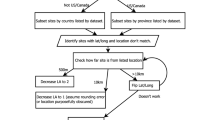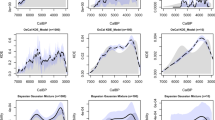Abstract
Few historical archaeologists working on sites that postdate A.D. 1500 employ radiocarbon dating throughout the course of their research. We argue that historical archaeologists underutilize radiocarbon dating, and present the case for its use and Bayesian modeling of the dates. We illustrate these methods with a simulated hypothetical example and an archaeological example from the mission period in the American Southeast. Our work shows that through the careful consideration of sample selection and the integration of prior knowledge regarding the archaeological record, one can dramatically increase the precision of radiocarbon dating on samples from historical sites, which can play an important role in secondary research question formulation and sampling across historical sites.
Abstracto
Pocos arqueólogos que trabajan en sitios históricos posteriores a 1500 D.C. emplean la datación por radiocarbono durante el curso de sus investigaciones. En este artículo se sostiene que los arqueólogos históricos subutilizan la datación por radiocarbono, y se presenta el argumento a favor de su uso y de los modelos bayesianos para las fechas. Se ilustran los métodos con un ejemplo hipotético simulado y un ejemplo arqueológico del período de las misiones en el sureste estadounidense. A través de una cuidadosa consideración de la selección de muestras y la integración de conocimientos previos sobre el registro arqueológico, es posible aumentar notablemente la precisión de la datación por radiocarbono en muestras procedentes de sitios históricos, que podrán desempeñar un papel importante en la formulación de preguntas y muestreo en la investigación secundaria de sitios históricos.
Résumé
Peu d’archéologues historiques travaillant dans des sites ultérieurs à l’an 1500 de notre ère ont recours à la datation par le carbone 14 dans le cadre de leur recherche. Le présent article avance que les archéologues historiques sous-utilisent cette méthode. Il plaide ainsi en faveur de son utilisation et de la modélisation bayésienne des dates. Les méthodes sont illustrées à l’aide d’un exemple hypothétique simulé et d’un exemple archéologique de la période des missions du Sud-est américain. En tenant soigneusement compte des échantillons choisis et en intégrant des données déjà acquises sur le dossier archéologique, on peut dramatiquement rehausser la précision de la datation par le carbone 14 des échantillons provenant de sites historiques, lesquels peuvent jouer un rôle important dans la formulation des hypothèses de recherche secondaires et l’échantillonnage des sites historiques.





Similar content being viewed by others
References
Bayliss, Alex, Christopher Bronk Ramsey, Johannes van der Plicht, and Alasdair Whittle 2007 Bradshaw and Bayes: Towards a Timetable for the Neolithic. Cambridge Archaeological Journal 17(S1):1–28.
Bayliss, Alex, Johannes van der Plicht, Christopher Bronk Ramsey, Gerry McCormac, Frances Healy, and Alasdair Whittle 2011 Towards Generational Time-Scales: The Quantitative Interpretation of Archaeological Chronologies. In Gathering Time: Dating the Early Neolithic Enclosures of Southern Britain and Ireland, Alasdair Whittle, Frances Healy, and Alex Bayliss, editors, pp. 17–59. Oxbow Books, Oxford,UK.
Braje, Todd J., and Torben C. Rick 2015 Identifying Specialized 19th Century Fishing Camps on California’s Northern Channel Islands: Applying AMS Radiocarbon Dating to Historical Sites. Radiocarbon 57(5):909–916.
Buck, Caitlin E., and J. Andrés Christen 1998 A Novel Approach to Selecting Samples for Radiocarbon Dating. Journal of Archaeological Science 25(4):303–310.
Cherkinsky, Alexander, Thomas J. Pluckhahn, and Victor D. Thompson 2014 Variation in Radiocarbon Age Determinations from the Crystal River Archaeological Site, Florida. Radiocarbon 56(2):801–810.
Deagan, Kathleen 1987 Artifacts of the Spanish Colonies of Florida and the Caribbean, 1500–1800. Vol. 1, Ceramics, Glassware, and Beads. Smithsonian Institution, Washington DC.
Griffiths, Seren, Alex Bayliss, Ben Ford, Mark Hounslow, Vassil Karloukovski, Christopher Bronk Ramsey, Gordon Cook, and Peter Marshall 2011 Scientific Dating and Chronology. In Winchester: A City in the Making, Archaeological Excavations between 2002 and 2007 on the Sites of Northgate House, Staple Gardens and the Former Winchester Library, Jewry St, B. M. Ford and S. Teague, editors, pp. 225–236. Oxford Archaeology, Oxford, UK.
Hamilton, Derek W., Colin Haselgrove, and Chris Gosden 2015 The Impact of Bayesian Chronologies on the British Iron Age. World Archaeology 47(4):642–660.
Hamilton, Derek W., and Anthony M. Krus 2018 The Myths and Realities of Bayesian Chronological Modeling Revealed. American Antiquity 83(2):187–203.
Hill, Matthew, Jr., Margaret E. Beck, Stacey Lengyel, Sarah J. Trabert, and Mary J. Adair 2017 A Hard Time to Date: The Scott County Pueblo (14SC1) and Puebloan Residents of the High Plains. American Antiquity 83(1):54–74.
Hutchinson, Dale L., Clark S. Larsen, Margaret J. Schoeninger, and Lynette Norr 1998 Regional Variation in the Pattern of Maize Adoption and Use in Florida and Georgia. American Antiquity 63(3):397–416.
Jefferies, Richard W., and Christopher R. Moore 2010 Recent Investigations of Mission Period Activity on Sapelo Island, Georgia. Journal of Global Initiatives: Policy, Pedagogy, Perspective 5(1):67–85.
Jefferies, Richard W., and Christopher R. Moore 2013 Mission San Joseph de Sapala: Mission-Period Archaeological Research. In Life Among the Tides: Recent Archaeology on the Georgia Bight, Victor D. Thompson and David Hurst Thomas, editors, pp. 17–22. American Museum of Natural History, New York, NY.
Jefferies, Richard W., and Christopher R. Moore 2018 Mission San Joseph de Sapala: 17th Century Franciscan Mission Efforts on Sapelo Island, Georgia. In Franciscan Florida in Pan-Borderlands Perspective: Adaptation, Negotiation, and Resistance, Jeffrey M. Burns, editor. Academy of American Franciscan History, Oceanside, CA.
Krus, Anthony M. 2016 The Timing of Precolumbian Militarization in the US Midwest and Southeast. American Antiquity 81(2):375–388.
Larsen, Clark S., Mark C. Griffin, Dale L. Hutchinson, Vivian E. Noble, Lynette Norr, Robert F. Pastor, Christopher B. Ruff, Katherine F. Russell, Margaret J. Schoeninger, Michael Schultz, Scott W. Simpson, and Mark F. Teaford 2001 Frontiers of Contact: Bioarchaeology of Spanish Florida. Journal of World Prehistory 15(1):69–123.
Lulewicz, Jacob 2017 Radiocarbon Data, Bayesian Modeling, and Alternative Historical Frameworks: A Case Study from the US Southeast. Advances in Archaeological Practice 6(1):58–71.
Marshall, Peter D., John Meadows, Alex Bayliss, R. Sparks, Christopher Bronk Ramsey, and Nancy Beavan-Athfield 2010 Scientific Dating. In The Beautiful Rooms are Empty: Excavations at Binchester Roman Fort, County Durham, 1976–1981 and 1986–1991, I. M. Ferris, editor, pp. 527–538. Durham County Council, Durham, UK.
Overholtzer, Lisa 2014 A New Bayesian Chronology form Postclassic and Colonial Occupation at Xaltocan, Mexico. Radiocarbon 56(3):1077–1092.
Overholtzer, Lisa 2015 Agency, Practice, and Chronological Context: A Bayesian Approach to Household Chronologies. Journal of Anthropological Archaeology 37:37–47.
Pluckhahn, Thomas, Victor D. Thompson, and Alex Cherkinsky 2015 The Temporality of Shell-Bearing Landscapes at Crystal River, Florida. Journal of Anthropological Archaeology 37:19–36.
Pluckhahn, Thomas J., and Victor D. Thompson 2017 Woodland-Period Mound Building as Historical Tradition: Dating the Mounds and Monuments at Crystal River (8CI1). Journal of Archaeological Science Reports 15:73–94.
Ramsey, Christopher B. 2009 Dealing with Outliers and Offsets in Radiocarbon Dating. Radiocarbon 51(3):1023–1045.
Reimer, Paula J., Edouard Bard, Alex Bayliss, J. Warren Beck, Paul G. Blackwell, Christopher Bronk Ramsey, Caitlin E. Buck, Hai Cheng, R. Lawrence Edwards, Michael Friedrich, Pieter M. Grootes, Thomas P. Guilderson, Haflidi Haflidason, Irka Hajdas, Christine Hatté, Timothy J. Heaton, Dirk L. Hoffmann, Alan G. Hogg, Konrad A. Hughen, K. Felix Kaiser, Bernd Kromer, Sturt W. Manning, Mu Niu, Ron W. Reimer, David A. Richards, E. Marian Scott, John R. Southon, Richard A. Staff, Christian S. M. Turney, and Johannes van der Plicht 2013 IntCal13 and Marine13 Radiocarbon Age Calibration Curves 0–50,000 Years Cal BP. Radiocarbon 55(4):1869–1887.
Ritchison, Brandon T. 2017 Exploring a Bayesian Method for Examining the Regional Ceramic Sequence along the Georgia Coast. Southeastern Archaeology 37(1):12–21.
Sidell, Jane, Christopher Thomas, and Alex Bayliss 2007 Validating and Improving Archaeological Phasing at St. Mary Spital, London. Radiocarbon 49(2):593–610.
Thomas, David Hurst 2008 Native American Landscapes of St. Catherines Island, Georgia. American Museum of Natural History, New York, NY.
Thomas, David Hurst 2009 Late Aboriginal Ceramics from St. Catherines Island (cal A.D. 1400–1700). In From Santa Elena to St. Augustine: Indigenous Ceramic Variability (A.D. 1400–1700), Kathleen Deagan and David Hurst Thomas, editors, pp. 49–81. American Museum of Natural History, New York, NY.
Thompson, Victor D. 2018 Collective Action and Village Life during the Late Archaic on the Georgia Coast. In The Archaeology of Villages in Eastern North America, Jennifer Birch and Victor D. Thompson, editors. University Press of Florida, Gainesville.
Thompson, Victor D., and Anthony Krus 2018 Contemplating the History and Future of Radiocarbon Dating in the American Southeast. Southeastern Archaeology 37(1):1–11.
Thompson, Victor D., William Marquardt, Alexander Cherkinsky, Amanda Roberts Thompson, Karen Walker, and Lee Newsom 2016 From Shell Midden to Shell Mound: The Geoarchaeology of Mound Key, an Anthropogenic Island in Southwest Florida, USA. PLoS ONE 11(4):e0154611.
Thompson, Victor D., and Christopher R. Moore 2015 The Sociality of Surplus among Late Archaic Hunter-Gatherers of Coastal Georgia. In Surplus: The Politics of Production and Strategies of Everyday Life, Christopher T. Morehart and Kristin De Lucia, editors, pp. 245–266. University of Colorado Press, Boulder.
Turck, John A., and Victor D. Thompson 2016 Revisiting the Resilience of Late Archaic Hunter-Gatherers along the Georgia Coast. Journal of Anthropological Archaeology 43:39–55.
Whittle, Alasdair, Frances Healy, and Alex Bayliss 2011 Gathering Time: Dating the Early Neolithic Enclosures of Southern Britain and Ireland. Oxbow Books, Oxford, UK.
Worth, John E. 2004 Yamasee. In Handbook of North American Indians, Vol. 14, Southeast, R. D. Fogelson, editor, pp. 245–253. Smithsonian Institution, Washington DC.
Worth, John E. 2007 The Struggle for the Georgia Coast. University of Alabama Press, Tuscaloosa.
Acknowledgments:
The authors would like to thank Jeff Speakman, Director of the University of Georgia’s Center for Applied Isotope Studies, for his support of our work. We appreciate the comments of Tony Krus and Chris Rodning, whose reading improved the overall quality of this paper. We extend our gratitude to Bryan Tucker and the State Historic Preservation Division of the Georgia Department of Natural Resources for their support of research on Sapelo Island. Funding for the radiocarbon dates was made possible by a University of Indianapolis InQuery Collaborative Grant and by grants from the Georgia Department of Natural Resources. Finally, we thank the two anonymous reviewers for their constructive comments on our manuscript.
Author information
Authors and Affiliations
Corresponding author
Additional information
Publisher’s Note
Springer Nature remains neutral with regard to jurisdictional claims in published maps and institutional affiliations.
Rights and permissions
About this article
Cite this article
Thompson, V.D., Jefferies, R.W. & Moore, C.R. The Case for Radiocarbon Dating and Bayesian Analysis in Historical Archaeology. Hist Arch 53, 181–192 (2019). https://doi.org/10.1007/s41636-018-0152-5
Accepted:
Published:
Issue Date:
DOI: https://doi.org/10.1007/s41636-018-0152-5




